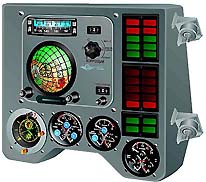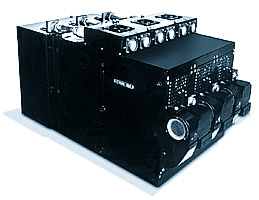The political imperative to keep the Soviet space program "failure-free" compelled the leaders of this program to choose the simplest, well-tested, most reliable technical solutions. It is often claimed that these considerations delayed the implementation of computer technology on board Soviet spacecraft and hampered the development of the Soviet space program in general. This web project is aimed to examine critically such views and to document the development of Soviet onboard computers in a larger technological, institutional, and political context.
The failure of hasty, scattered, and underfunded Soviet attempts to catch up with the Apollo lunar program illuminated numerous shortcomings of the Soviet space industry. In the early 1970s, the Soviet Union made a strategic turn toward the construction of long-term space stations with an extensive program of onboard research. Cosmonauts gradually began to play a more prominent role in the space program, although numerous failures of automatic systems and unsuccessful manual dockings in the absence of onboard guidance computers significantly slowed down the Soviet program.
A particularly important role in the evolution of the Soviet approach to automation belonged to the attempts to develop and use onboard computers. Soviet designers of spacecraft control systems became interested in computers at about the same time as engineers at MIT's Instrumentation Laboratory began working on the Apollo Guidance Computer. In the early 1960s as the Experimental Design Bureau No. 1, led by the chief designer Sergei Korolev, was working on the new Soyuz spacecraft, control system designers attempted to acquire an onboard electronic digital computer for the Soyuz, but none of the Soviet organizations involved in the design and production of computers was able to meet their specifications. As a result, the Soyuz spacecraft was initially designed without an onboard computer.
In August 1969, the 7K-L1 spacecraft named Zond-7 guided by the Argon-11S completed the first fully successful Soviet circumlunar mission. 21 copies of the Argon were built at a pilot production facility for the Soviet lunar program. Two more models, the Argon-12A and the Argon-12S, were designed for the space station and the landing module of the Almaz complex, the centerpiece of this program. After a series of costly failures, none of which was caused by computers, the Soviet lunar program was terminated, and none of these computers went into serial production. In 1967-1970, the Central Design Bureau of Experimental Machine Building, or TsKBEM (the former Experimental Design Bureau No. 1, now called the Energiia Rocket and Space Corporation) proposed to develop a military version of the Soyuz known as 7K-S as part of a larger military station Soyuz-VI. The Soyuz-VI project was cancelled in February 1970, but the Bureau decided to continue with the development of the 7K-S. Its revised design, approved on August 11, 1972, included an onboard digital computer, the Argon-16. In 1973 NICEVT completed the computer complex Argon-16, but in 1974 the Soviet military decided that they didn't really need a military version of the Soyuz. As a result, the Energiia Corporation decided to use a modified version of 7K-S, called 7K-ST, as a transport ship for its Salyut space stations. Three 7K-S vehicles (all unmanned) were launched between 1974 and 1976. These were the first Soviet manned spaceships using digital computers, although the vehicles themselves were unmanned for these tests. Two "new" 7K-ST vehicles were launched in 1978-1979. A third 7K-ST was launched in December 1979 and became publicly known as the Soyuz-T spacecraft (all the previous missions were concealed under the "Kosmos" designation). Finally in June 1980, Soyuz T-2 with the Argon-16 computer on board carried a two-man crew into space. This was the first Soviet piloted ship guided by an onboard computer. In the meantime, another computer design organization, the Scientific Research Institute of Micro-Instruments (NII MP), located in Zelenograd near Moscow, began producing the Salyut series of onboard computers for the Soviet space program. The Salyut-2M computers were installed on board the Salyut-2 and the Salyut-3 space stations; they were not used for guidance but for control of onboard equipment, such as observation instruments. The Salyut-2M with a new operating system was also installed on board the Salyut-4 station, where it calculated the station trajectory in real time, serving as a check-up and back-up for ground control. The cosmonauts used this machine mostly for information display, scheduling, and planning. On the Salyut-7 station, the Salyut-2M computer became part of the control system. It was linked to the analog control loop, and it manipulated with signals from various sensors to "deceive" the analog control system so that it performed various experiments and trajectory corrections. Despite many breakdowns on the Salyut-7, the onboard computer worked until the last minute, when the power was finally shut down. On the Mir space station, several different types of computers were used: the Argon-16, the Salyut-4, the Salyut-5 (a replacement for the Argon), and another small computer, a version of peripheral exchange adapter, also made in Zelenograd (see Yurii Zybin's interview). Unlike Korolev's and Chelomey's design bureaus, which ordered computer hardware from other manufacturers, the Scientific Research Institute of Automatics and Instrument-Making (NII AP), led by Nikolai Pilyugin, the chief designer of control systems for Soviet spacecraft, designed and developed its own onboard computers. For the second phase of the development of the lunar complex N1-L3, Pilyugin's institute designed a new control system based on the S-530 computer. It was intended for calculating all control tasks: guidance, control of the operating logic of the control system's own equipment, and control of the engines and of all other systems in the N1 rocket. There were plans to use the same machine for the control system of the LOK (the lunar orbital ship) and the LK (the lunar ship). The S-530 computer was installed on board the N1 rocket at its fourth launch attempt on November 23, 1972, which ended unsuccessfully, and the computer was never tested in flight. After that, Pilyugin's institute developed its own series of onboard computers, the Bisser. The Bisser-2 was designed in the late 1970s-early 1980s, and it was installed on the Zenith-2 rockets. The Bisser-3 was installed on the Zenith-3 rockets, on the acceleration module of the Sea Launch complex, and on the acceleration module of the Frigate complex. The development of the Bisser-3 went in parallel with work on the Bisser-4, the onboard computer system for the Buran space shuttle. This organization, now called the Pilyugin Research-and-Production Center of Automatics and Instrument-Making (NPTs AP), is currently working on the latest model, the Bisser-6 (see Georgii Priss's interview). Other organizations involved in the design and production of onboard computers included the Research-and-Production Association Khartron, which built computer complexes for intercontinental ballistic missiles, for research modules of the Mir space station, and for the most powerful in the world carrier rocket Energia (see Anatoly Krivonosov's essay), and the Kiev Radio Factory, which manufactured the first Soviet serially produced onboard computer on integrated circuits, the 15L579 (designed at Khartron), for the 15A30 rocket (designed at the Moscow Central Design Bureau of Machinery Construction; the chief designer Vladimir Chelomei). (see Boris Vasilenko's essay). Information display systems (IDS) for Soviet spacecraft and training simulators for the cosmonauts were developed by the Specialized Experimental Design Bureau of Spacecraft Technology of the Flight Research Institute in Zhukovskii near Moscow. The first generation of IDS, designed for the Vostok and the Voskhod spacecraft, worked with analog equipment, while later generations became increasingly integrated with onboard computer systems. Bureau designers drew on their experience with the design of IDS for aviation and for nuclear industry to develop over 50 different types of IDS for various models of spacecraft, which implemented innovative methods of information compression and display and new types of manual controls; the Bureau also designed 23 simulators for the Soviet space program (see Yurii Tiapchenko's overview essay and interview). The Bureau worked closely with researchers from the Pavlov Institute of Physiology, the Institute of Psychology, the Institute of Cybernetics, the departments of psychology, medicine, and biology of Moscow State University, and other academic organizations to study characteristics of human information reception and to develop methods and criteria for evaluation of information display devices, control devices, and information representation methods. Currently the Bureau is subordinated to the Scientific Research Institute of Aviation Equipment. This project examines the crucial issue of automation vs. human control largely underestimated by standard histories of the Soviet space program with a specific focus on the introduction of computers on board. I have argued elsewhere that automation through computerization can be either machine-centered or human-centered ("Automation," in The Encyclopedia of Computer Science [2000]). Computers on board could potentially be used either way: to enhance automation or to facilitate manual control of the spacecraft. In the US the first guidance computer was installed on board a piloted spacecraft in 1965 (the Gemini program), which made it possible to carry out the first manual docking, since the onboard computer helped the astronauts with necessary calculations (see Tom Sheridan's interview). The Soviet Union, on the other hand, launched the first piloted ship with an onboard guidance computer as late as 1980, even though the first onboard computer had been successfully used on an unmanned spacecraft as early as 1968. This project examines the technical, social, and economic, and political factors that shaped the development of Soviet onboard computing in a direction different from the US, and it analyzes the consequences of the delay in the introduction of onboard guidance computers for the Soviet piloted space program. |

 This project covers the period from the launch of Sputnik in 1957 to the launch of the Buran, the Soviet space shuttle, in 1988. The first piloted spacecraft, the Vostok and the Voskhod, were almost entirely automatic with back-up manual control systems. As the space exploration agenda became more ambitious and included such complex tasks as rendezvous, docking, and lunar landing, the designers of the new Soyuz spacecraft faced the problem of optimal division of functions between human and machine on
board (see essays by
This project covers the period from the launch of Sputnik in 1957 to the launch of the Buran, the Soviet space shuttle, in 1988. The first piloted spacecraft, the Vostok and the Voskhod, were almost entirely automatic with back-up manual control systems. As the space exploration agenda became more ambitious and included such complex tasks as rendezvous, docking, and lunar landing, the designers of the new Soyuz spacecraft faced the problem of optimal division of functions between human and machine on
board (see essays by 
 In August 1964, trying to catch up with the Apollo program, the Soviet Union launched its own lunar landing project. A new spacecraft code named 7K-L1 (later publicly named Zond) was designed, and its control system included, for the first time in a Soviet spacecraft, an onboard electronic digital computer, the
In August 1964, trying to catch up with the Apollo program, the Soviet Union launched its own lunar landing project. A new spacecraft code named 7K-L1 (later publicly named Zond) was designed, and its control system included, for the first time in a Soviet spacecraft, an onboard electronic digital computer, the